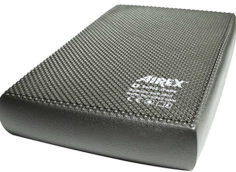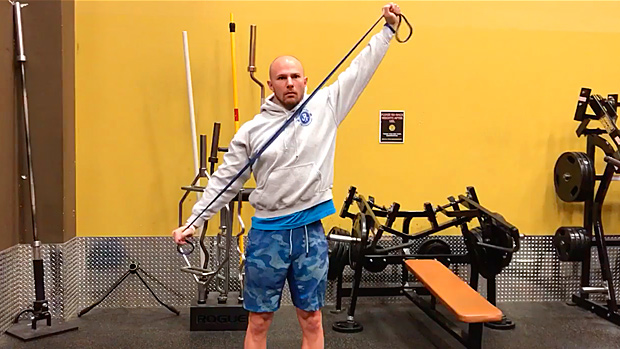Several months ago, Dr. Mike Roussell wrote 7 Nutritional Strategies for Strategic Overreaching for T Nation that contained 7 key strategies for maximizing overreaching (also known as strategic overtraining).
The 7 key strategies were supplementing with creatine, acetyl l-carnitine, and BCAAs, monitoring and protecting your sleep, and optimizing neurotransmitters through supplementation – all important steps that can help maximize your overreaching efforts.
The problem is, how can you optimize your overreaching if you don't know how to properly execute an overreaching training program? This article will attempt to address this by laying out a complete overreaching protocol for you to follow.
Eat Like, A Lot
This program is set up into four phases. The first phase ensures that you're in a trained state before overreaching, which occurs in the second two phases.
The final phase is the taper phase, when your body will rebound and super compensate. During the taper phase you'll need to recalculate your macronutrients and calorie needs because even though you still want to be in a caloric surplus, your training loads will be much less and it's wise to account for those changes.
The easiest place to start is using the calorie calculating process outlined by Dr. John Berardi in his classic Massive Eating article.
This is one of the most comprehensive and aggressive calorie calculators you can find (even accounting for the thermic effect of food), so despite your hard, frequent, total body workouts, you'll be giving your body the nutrients it needs.
Bottom line, if you want to get the most out of strategic overreaching then your nutrition must be dialed in.
Carbohydrates
Don't go carbohydrate crazy but eat plenty of starchy/grain-based carbs in the first two meals following your workout. If you're an ectomorph/hardgainer, eat more starchy/grain-based carbs at breakfast as well.
Forty percent calories from carbohydrates is more than sufficient. This will give you enough carbohydrates to saturate your muscles during and post training while leaving enough calories from fat and protein to fuel the rest of your day.
Before Bed
Use your nighttime slumber as an added opportunity for recovery. 2-3 scoops of Metabolic Drive® Low Carbwill give you a hefty dose of casein to feed your system while you dream.
Workout Nutrition
When performing full body training sessions 5 days per week, fueling your training session and jumpstarting recovery are critical.
If you're an endomorph or mesomorph, cyclic dextrin, the carbohydrate found in BIOTEST Plazma™, is the carbohydrate of choice. This unique carb is designed to get into your system quickly and fuel your working muscles during intense training, without forcing your body to release massive amounts of insulin.
In the protein department, amino acids and hydrolyzed proteins are ideal choices during workouts, hitting your system quickly and helping create a sustained anabolic environment.
The best practice is to pre-load your blood stream with the key nutrients your muscles crave by starting your peri-workout nutrition 30-45 minutes out from your training session and continuing throughout the workout.
Sleep
I touched on sleep in the previous article but it's worth mentioning again as insufficient sleep will be the number one rate-limiting step for many embarking on this program.
Upon starting the program you should add one sleep cycle to each 24-hour span. This means 90 more minutes of concentrated sleep (not 30 more minutes at night and a 60-minute nap).
Adding either 90 minutes to your nighttime slumber or a 90-minute nap (which is hard for most people) is key and will provide both neurorestorative and physical restorative sleep – both of which are crucial in this program.
Track your HRV
T Nation has posted an article on heart rate variability (HRV).
If you're on the fence or haven't taken the HRV plunge, read this: monitoring the changes in your HRV is the most valuable tool at your disposal for monitoring your body's recovery.
With overreaching, this becomes even more important because you're going to be strong-arming your body into a situation where you can't recover fully.
However, there's a fine line between strategic overreaching and overtraining, and tracking your daily changes in HRV allows you to objectively see your recovery state and determine whether you're overreaching or stumbling into overtraining. I use BioForce HRV daily.

Your Training Program
Sometimes a step backward is necessary to take a step forward – it's an easy analogy to relate to overreaching programs. What we do in this program is create a physiological hell that results in big gains, which is what researchers at UCONN had in mind when they designed the first adaptation of the overreaching protocol you're about to follow.
Their goal was to investigate how creatine supplementation affects hormones while following an overreaching strength program. They couldn't make any conclusive links between creatine supplementation and hormonal response, but they did find creatine useful for braving a 4-week physiological storm as subjects in their experimental group outperformed the control group in intra-program and post-program testing.
While the control group saw intra-program performance detriments from week to week, the creatine group remained relatively unscathed – a solid example of the importance of supplementation during times of high physiological stress.
During the UCONN program subjects were loaded up with what most would call middle-range reps (in our world, high reps, haha) and subsequently progressed to low reps at the end of the overreaching phase.
It allowed for the buildup of a ton of stress and ample fitness-masking fatigue, with a gradual step down into the deloading/tapering phase. This is where the "rebound effect" makes an appearance.
While we're experiencing the hell of overreaching, the body is adapting to the stress it's under. Hidden underneath the hell is a monster, sizeable and strong. The de-load after overreaching releases the monster and unveils strength and body composition changes.
The current program is an adaptation of the UCONN program. They did a great job of creating an overreaching protocol, but I wasn't keen on the exercise selection and a few of the loading parameters, so I changed them.
As a result, you'll be doing less rep max work and use slightly lower rep ranges at the onset of the overreaching period. I've also thrown in some neural charge training to help you recover. (If you're unfamiliar with neural charge training, check out this The 600-Pound Deadlift Textbook.
Our goal is strength with mass being a bonus. Normally I wouldn't program reps this high for main lifts – at least not for a strength based program – but they're necessary to create the high-stress, physiological response. Also, too much heavy loading too soon will catapult a lifter from overreaching to overtraining.
I've also added in high-frequency bench press and deadlift training. These are the lifts tested before and after the program, so you'll spend considerable time getting great at them.
To determine loads for each lift we'll employ the RPE scale. If you need to brush up on how to use it, check out Mike Tuscherer's How to Modulate Intensity. It's an extremely effective yet easy to use method that more lifters should become familiar with.
(In the program below, for each set the target RPE between 1 and 10 is indicated immediately after the reps – e.g., 3 x 6 @ 6 means 3 sets of 6 reps at an RPE of 6 out of 10).
The Program
Here's your overreaching protocol: 4 weeks of prep work, 2 weeks of higher-rep overreaching, 2 weeks of heavier loads, and a 2-week rebound period.
Note: Three days before starting week one, test your bench press and deadlift 1-rep max.
4 Week Prep Program
(2 days on, 1 day off, 2 days on, 2 days off)
Day 1
| Exercise | Week 1 | Week 2 | Week 3 | Week 4 | Rest | |
| A1 | Deadlift | 3 x 6 @ 6 | 4 x 5 @ 6 | 4 x 5 @ 6 | 8 x 3 @ 6 | 90 sec. |
| A2 | Bench Press | 3 x 6 @ 6 | 4 x 5 @ 6 | 4 x 5 @ 6 | 8 x 3 @ 6 | 90 sec. |
| B1 | Floor Press | 3 x 6 @ 8 | 3 x 8 @ 8 | 4 x 6 @ 8 | 4 x 6 @ 8 | 90 sec. |
| B2 | Chest Supported Row | 3 x 6 @ 8 | 3 x 8 @ 8 | 4 x 6 @ 8 | 4 x 6 @ 8 | 90 sec. |
| C1 | Push-Up on Dumbbells | 3 x 6 @ 8 | 3 x 8 @ 8 | 4 x 6 @ 8 | 4 x 6 @ 8 | 60 sec. |
| C2 | Seated Row | 3 x 6 @ 8 | 3 x 8 @ 8 | 4 x 6 @ 8 | 4 x 6 @ 8 | 60 sec. |
Day 2
| Exercise | Week 1 | Week 2 | Week 3 | Week 4 | Rest | |
| A1 | Deadlift | 3 x 6 @ 6 | 4 x 5 @ 6 | 5 x 4 @ 6 | 8 x 3 @ 6 | 90 sec. |
| A2 | Bench Press | 3 x 6 @ 6 | 4 x 5 @ 6 | 5 x 4 @ 6 | 8 x 3 @ 6 | 90 sec. |
| B1 | Rack Pull | 3 x 6 @ 8 | 3 x 8 @ 8 | 4 x 6 @ 8 | 4 x 6 @ 8 | 90 sec. |
| B2 | T-Spine Mobility | 90 sec. | ||||
| C1 | Romanian Deadlift | 3 x 6 @ 8 | 3 x 8 @ 8 | 4 x 6 @ 8 | 4 x 6 @ 8 | 60 sec. |
| C2 | Goblet Step-Up | 3 x 6 @ 8 | 3 x 8 @ 8 | 4 x 6 @ 8 | 4 x 6 @ 8 | 60 sec. |
Day 3
| Exercise | Week 1 | Week 2 | Week 3 | Week 4 | Rest | |
| A1 | Deadlift | 3 x 6 @ 6 | 4 x 5 @ 6 | 5 x 4 @ 6 | 8 x 3 @ 6 | 90 sec. |
| A2 | Bench Press | 3 x 6 @ 6 | 4 x 5 @ 6 | 5 x 4 @ 6 | 8 x 3 @ 6 | 90 sec. |
| B1 | Overhead Press | 3 x 6 @ 8 | 3 x 8 @ 8 | 4 x 6 @ 8 | 4 x 6 @ 8 | 90 sec. |
| B2 | Pull-Up | 3 x 6 @ 8 | 3 x 8 @ 8 | 4 x 6 @ 8 | 4 x 6 @ 8 | 90 sec. |
| C1 | Incline Dumbbell Press | 3 x 6 @ 8 | 3 x 8 @ 8 | 4 x 6 @ 8 | 4 x 6 @ 8 | 60 sec. |
| C2 | Neutral Grip Pulldown | 3 x 6 @ 8 | 3 x 8 @ 8 | 4 x 6 @ 8 | 4 x 6 @ 8 | 60 sec. |
Day 4
| Exercise | Week 1 | Week 2 | Week 3 | Week 4 | Rest | |
| A1 | Deadlift | 3 x 6 @ 6 | 4 x 5 @ 6 | 5 x 4 @ 6 | 8 x 3 @ 6 | 90 sec. |
| A2 | Bench Press | 3 x 6 @ 6 | 4 x 5 @ 6 | 5 x 4 @ 6 | 8 x 3 @ 6 | 90 sec. |
| B1 | Front Squat | 3 x 6 @ 8 | 3 x 8 @ 8 | 4 x 6 @ 8 | 4 x 6 @ 8 | 90 sec. |
| B2 | Ankle Mobility | 90 sec. | ||||
| C1 | Dumbbell Split Squat | 3 x 6 @ 8 | 3 x 8 @ 8 | 4 x 6 @ 8 | 4 x 6 @ 8 | 60 sec. |
| C2 | Single-Leg Romanian Deadlift | 3 x 6 @ 8 | 3 x 8 @ 8 | 4 x 6 @ 8 | 4 x 6 @ 8 | 60 sec. |
Overreaching Weeks 1 and 2
(5 days on, 2 days off)
Day 1
| Exercise | Week 1 | Week 2 | Rest | |
| A1 | Deadlift | 8 x 3 @ 6 | 8 x 3 @ 6 | 90 sec. |
| A2 | Bench Press | 8 x 3 @ 6 | 8 x 3 @ 6 | 90 sec. |
| B1 | Bench Press | 4 x 8 @ 8 | 3 x 8 @ 9 | 90 sec. |
| B2 | Chest Supported Row | 4 x 8 @ 8 | 3 x 8 @ 9 | 90 sec. |
| C1 | Dumbbell Bench Press | 4 x 8 @ 8 | 3 x 8 @ 9 | 60 sec. |
| C2 | Inverted Row | 4 x 8 @ 8 | 3 x 8 @ 9 | 60 sec. |
Day 2
| Exercise | Week 1 | Week 2 | Rest | |
| A1 | Deadlift | 8 x 3 @ 6 | 8 x 3 @ 6 | 90 sec. |
| A2 | Bench Press | 8 x 3 @ 6 | 8 x 3 @ 6 | 90 sec. |
| B1 | Rack Pull | 4 x 8 @ 8 | 3 x 8 @ 9 | 90 sec. |
| B2 | T-Spine Mobility | 90 sec. | ||
| C1 | Snatch Grip Romanian Deadlift | 4 x 8 @ 8 | 3 x 8 @ 9 | 60 sec. |
| C2 | Goblet Step-Up | 4 x 8 @ 8 | 3 x 8 @ 9 | 60 sec. |
Day 3
| Exercise | Week 1 | Week 2 | Rest | |
| A1 | Deadlift | 8 x 3 @ 6 | 8 x 3 @ 6 | 90 sec. |
| A2 | Bench Press | 8 x 3 @ 6 | 8 x 3 @ 6 | 90 sec. |
| B1 | Overhead Press | 4 x 8 @ 8 | 3 x 8 @ 9 | 90 sec. |
| B2 | Pull-Up | 4 x 8 @ 8 | 3 x 8 @ 9 | 90 sec. |
| C1 | Incline Dumbbell Press | 4 x 8 @ 8 | 3 x 8 @ 9 | 60 sec. |
| C2 | Neutral Grip Pulldown | 4 x 8 @ 8 | 3 x 8 @ 9 | 60 sec. |
Day 4
| Exercise | Week 1 | Week 2 | Rest | |
| A1 | Deadlift | 8 x 3 @ 6 | 8 x 3 @ 6 | 90 sec. |
| A2 | Bench Press | 8 x 3 @ 6 | 8 x 3 @ 6 | 90 sec. |
| B1 | Front Squat | 4 x 8 @ 8 | 3 x 8 @ 9 | 90 sec. |
| B2 | Ankle Mobility | 90 sec. | ||
| C | Dumbbell Split Squat | 4 x 8 @ 8 | 3 x 8 @ 9 | 60 sec. |
Day 5
Neural Charge
Overreaching Weeks 3 and 4
(5 days on, 2 days off)
Day 1
| Exercise | Week 3 | Week 4 | Rest | |
| A1 | Deadlift | 8 x 3 @ 6 | 8 x 3 @ 6 | 90 sec. |
| A2 | Bench Press | 8 x 3 @ 6 | 8 x 3 @ 6 | 90 sec. |
| B1 | Bench Press | 10 x 3 @ 8 | 5 x 3 @ 9 | 90 sec. |
| B2 | Chest Supported Row | 10 x 3 @ 8 | 5 x 3 @ 9 | 90 sec. |
| C1 | Dumbbell Bench Press | 10 x 3 @ 8 | 5 x 3 @ 9 | 60 sec. |
| C2 | Inverted Row | 10 x 3 * | 5 x 3 * * | 60 sec. |
with 5 sec. hold
* * with 8-10 sec. hold
Day 2
| Exercise | Week 3 | Week 4 | Rest | |
| A1 | Deadlift | 8 x 3 @ 6 | 8 x 3 @ 6 | 90 sec. |
| A2 | Bench Press | 8 x 3 @ 6 | 8 x 3 @ 6 | 90 sec. |
| B1 | Rack Pull | 10 x 3 @ 8 | 5 x 3 @ 9 | 90 sec. |
| B2 | T-Spine Mobility | 90 sec. | ||
| C1 | Snatch Grip Romanian Deadlift | 10 x 3 @ 8 | 5 x 3 @ 9 | 60 sec. |
| C2 | Goblet Step-Up | 10 x 3 @ 8 | 5 x 3 @ 9 | 60 sec. |
Day 3
| Exercise | Week 3 | Week 4 | Rest | |
| A1 | Deadlift | 8 x 3 @ 6 | 8 x 3 @ 6 | 90 sec. |
| A2 | Bench Press | 8 x 3 @ 6 | 8 x 3 @ 6 | 90 sec. |
| B1 | Overhead Press | 10 x 3 @ 8 | 5 x 3 @ 9 | 90 sec. |
| B2 | Pull-Up | 10 x 3 @ 8 | 5 x 3 @ 9 | 90 sec. |
| C1 | Incline Dumbbell Press | 10 x 3 @ 8 | 5 x 3 @ 9 | 60 sec. |
| C2 | Neutral Grip Pulldown | 10 x 3 @ 8 | 5 x 3 @ 9 | 60 sec. |
Day 4
| Exercise | Week 3 | Week 4 | Rest | |
| A1 | Deadlift | 8 x 3 @ 6 | 8 x 3 @ 6 | 90 sec. |
| A2 | Bench Press | 8 x 3 @ 6 | 8 x 3 @ 6 | 90 sec. |
| B1 | Front Squat | 10 x 3 @ 8 | 5 x 3 @ 9 | 90 sec. |
| B2 | Ankle Mobility | 90 sec. | ||
| C | Dumbbell Split Squat | 10 x 3 @ 8 | 5 x 3 @ 9 | 60 sec. |
Day 5
Neural Charge
Deload Weeks 5 and 6
Day 1
| Exercise | Week 5 | Week 6 | Rest | |
| A1 | Deadlift | 8 x 3 @ 6 | work up to single @ 8 | full |
| A2 | Bench Press | 8 x 3 @ 6 | work up to single @ 8 | full |
Day 2
Neural Charge
Day 3
| Exercise | Week 5 | Week 6 | Rest | |
| A1 | Deadlift | 8 x 3 @ 6 | work up to single @ 8 | full |
| A2 | Bench Press | 8 x 3 @ 6 | work up to single @ 8 | full |
Day 4
Neural Charge
Day 5
| Exercise | Week 5 | Week 6 | Rest | |
| A1 | Deadlift | 8 x 3 @ 6 | work up to max | full |
| A2 | Bench Press | 8 x 3 @ 6 | work up to max | full |
Training Tips
The first thing to remember is that this is a once-per-year type training protocol. Consistently overreaching, cycle after cycle, will eventually produce diminishing returns.
The best policy is to first asses your state of readiness by using HRV or an objective self-rating scale. You should also start this 10-week cycle after taking a few weeks off and hitting the reset button. If not, you'll overreach too soon and likely make a quick transition into overtraining.
Bear in mind that the A1/A2 complex at the beginning of each training day is for practice, warm-up, and CNS ramp-up purposes. By no means should these sets require a grand amount of work, only tension, speed, and good form.
These are the sets that will make the hell of overreaching worthwhile. While your body is withstanding a physiological barrage, these practice sets prepare your body to reap the benefits.
Stick vehemently to the rest periods – they're the key variable, our spearhead leading the overreaching charge. They elicit and manage intra-session stress.
Do your best during the four overreaching weeks to keep extraneous stress to a minimum. Remember Dr. Mike's advice on sleep and cut out the other crap. Ditch the booze, keep nutrition on point, and don't unnecessarily use adrenaline.
Summary
When planned, overreaching periods can produce big gains in short periods of time. Remember to limit extraneous stress while following a sound nutrition and supplement strategy.
And if you find your motivation waning or the training starts breaking you down, remember the words of Winston Churchill: "As you're going through hell, keep going." There are monster gains waiting for you on the other side.





